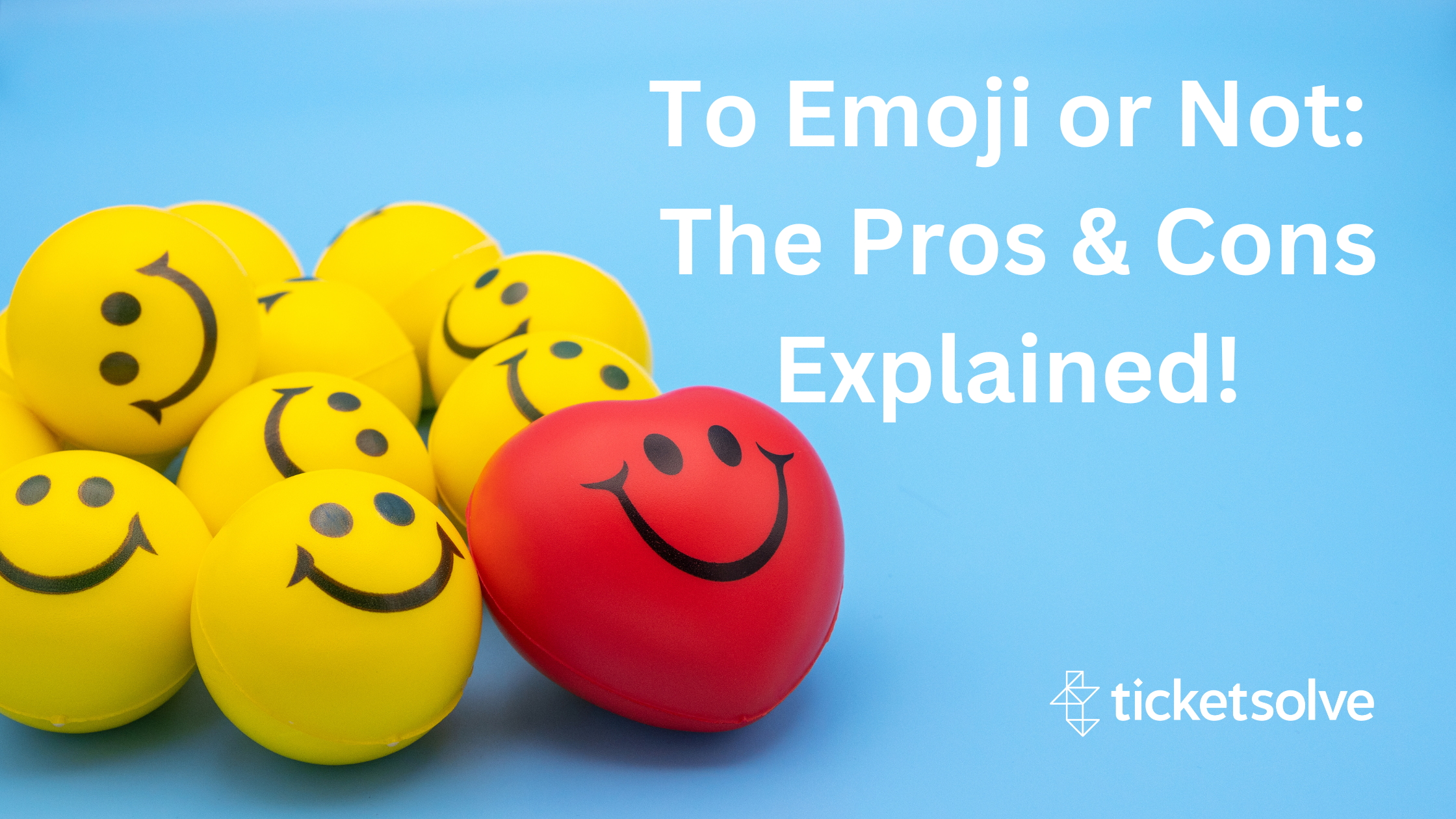To Emoji or Not 🤔: The Pros & Cons Explained

Once upon a time, we communicated with simple letters and punctuation marks. Fast forward to today, and we're using emojis – tiny digital images that express our emotions, and reactions, and even tell stories. As professionals in the arts and culture sector, we're all about expression, but should we be using emojis in our social and everyday content? Let's dive into the colourful world of emojis and discover how these modern-day hieroglyphs can enhance your communication at Ticketsolve.
The Rise of Emojis:
Emojis have come a long way since their birth in Japan in the 1990s. Today, they're an integral part of our digital lives, with over 3,000 emojis to choose from. From the classic smiley face to the dancing lady, there's an emoji for almost every occasion. But what does this mean for arts and culture professionals? Are emojis the future of communication, or are they just a passing fad?
The Pros of Emojis in Arts & Culture:
-
Emojis humanize your content: Emojis can add a touch of warmth and personality to your content, making it more engaging and personable. A well-placed emoji can help build a connection with your audience, making them feel like they're interacting with a real person, not just a faceless organization.
-
Emojis save space: When you're working with a limited character count, such as on Twitter, emojis can help convey your message without using up precious characters. This allows you to say more with less and get your point across more effectively.
-
Emojis are universal: Emojis are understood and appreciated by people from various cultural backgrounds and languages. They have the power to break down language barriers and create a sense of unity, which is particularly important in the diverse world of arts and culture.
The Cons of Emojis in Arts & Culture:
-
Emojis can be misinterpreted: The meaning of an emoji can vary depending on the context and the person interpreting it. This can lead to misunderstandings and miscommunications, which is never ideal in a professional setting.
-
Emojis may not be appropriate for all content: While emojis can be fun and engaging, they may not be suitable for all types of content, especially when discussing serious or sensitive topics. In such cases, using emojis could be seen as disrespectful or unprofessional.
-
Overuse can dilute your message: Emojis should be used sparingly and strategically. Overusing emojis can make your content appear cluttered and unprofessional, and may even detract from the message you're trying to convey.
Striking the Right Balance:
So, to emoji or not to emoji? The answer lies in finding the right balance. Here are some tips for using emojis effectively in your arts and culture content:
-
Know your audience: Consider the demographics and preferences of your audience. Are they likely to appreciate emojis, or would they prefer a more traditional approach?
-
Choose your emojis wisely: Not all emojis are created equal. Stick to emojis that are universally recognized and relevant to your content. Avoid obscure or controversial emojis that may cause confusion or offence.
-
Less is more: Use emojis sparingly and strategically to enhance your message, not overpower it. Remember, you want your content to be clear and professional, even when you're injecting a little personality.
Emojis can be a powerful tool in the arts and culture sector when used thoughtfully and sparingly. They can help humanize your content, save space, and create a sense of unity among your audience. However, it's essential to strike the right balance and be mindful of potential pitfalls. By following the tips outlined above, you can ensure that your emojis add value to your content and help you connect with your audience in a meaningful way.
Emojis can be an exciting addition to your social and everyday content if used thoughtfully. As arts and culture professionals, we have a unique opportunity to embrace this modern form of communication and use it to our advantage. So, go ahead and add a touch of colour and personality to your content, but always remember to keep it professional, engaging, and true to your brand. Embrace the emoji revolution, and let your creativity shine!
Categories
Recent posts
Archive
- December 2025 (1)
- November 2025 (1)
- October 2025 (3)
- September 2025 (1)
- August 2025 (3)
- July 2025 (3)
- June 2025 (3)
- May 2025 (4)
- April 2025 (5)
- March 2025 (5)
- February 2025 (4)
- January 2025 (4)
- December 2024 (3)
- November 2024 (5)
- October 2024 (4)
- September 2024 (7)
- August 2024 (5)
- July 2024 (3)
- June 2024 (3)
- May 2024 (3)
- April 2024 (3)
- March 2024 (4)
- February 2024 (5)
- January 2024 (3)
- December 2023 (3)
- November 2023 (4)
- October 2023 (4)
- September 2023 (5)
- August 2023 (3)
- July 2023 (4)
- June 2023 (4)
- May 2023 (5)
- April 2023 (4)
- March 2023 (4)
- February 2023 (5)
- January 2023 (4)
- December 2022 (4)
- November 2022 (3)
- October 2022 (4)
- September 2022 (5)
- August 2022 (2)
- July 2022 (4)
- June 2022 (5)
- May 2022 (4)
- April 2022 (5)
- March 2022 (3)
- February 2022 (4)
- January 2022 (4)
- December 2021 (2)
- November 2021 (3)
- October 2021 (5)
- September 2021 (4)
- August 2021 (4)
- July 2021 (3)
- June 2021 (4)
- May 2021 (2)
- April 2021 (4)
- March 2021 (5)
- February 2021 (4)
- January 2021 (5)
- December 2020 (4)
- November 2020 (4)
- October 2020 (5)
- September 2020 (5)
- August 2020 (4)
- July 2020 (7)
- June 2020 (5)
- May 2020 (5)
- April 2020 (5)
- March 2020 (8)
- February 2020 (4)
- January 2020 (5)
- December 2019 (3)
- November 2019 (5)
- October 2019 (4)
- September 2019 (4)
- August 2019 (5)
- July 2019 (4)
- June 2019 (4)
- May 2019 (5)
- April 2019 (4)
- March 2019 (4)
- February 2019 (3)
- January 2019 (5)
- December 2018 (4)
- November 2018 (8)
- October 2018 (2)
- September 2018 (3)
- August 2018 (5)
- July 2018 (4)
- June 2018 (4)
- May 2018 (1)
- April 2018 (1)
- March 2018 (3)
- February 2018 (2)
- December 2017 (2)
- November 2017 (3)
- October 2017 (4)
- September 2017 (2)
- August 2017 (1)
- July 2017 (5)
- June 2017 (3)
- May 2017 (2)
- April 2017 (3)
- March 2017 (2)
- February 2017 (3)
- January 2017 (3)
- December 2016 (4)
- November 2016 (1)
- September 2016 (1)
- July 2016 (3)
- June 2016 (1)
- May 2016 (2)
- April 2016 (2)
- February 2016 (1)
- January 2016 (3)
- December 2015 (2)
- September 2015 (1)
- August 2015 (2)
- July 2015 (1)
- June 2015 (2)
- May 2015 (2)
- April 2015 (5)
- March 2015 (2)
- February 2015 (2)
- January 2015 (4)
- December 2014 (3)
- November 2014 (3)
- October 2014 (2)
- September 2014 (3)
- August 2014 (3)
- July 2014 (3)
- June 2014 (7)
- May 2014 (6)
- April 2014 (3)
- March 2014 (2)
- February 2014 (1)
- January 2014 (3)
- December 2013 (1)
- August 2013 (1)
- June 2013 (1)
- April 2013 (1)
Sign up for regular updates


